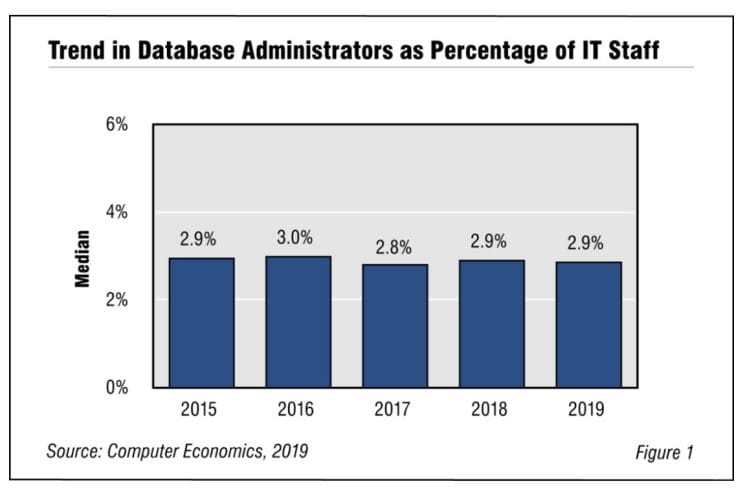Businesses are capturing and analyzing more data than ever, and they must ensure that their databases are secure and readily accessible. But despite these increased data demands, companies have been restraining the growth of their in-house DBA staff in recent years.
In 2019, the trend continues, as seen in Figure 1 from our full report, Database Administration Staffing Ratios. Database administrators have remained steady at 2.9% of the total IT staff at the median for three of the past five years, with just two slight variations during that period.

Several factors are working to restrain the growth of the in-house DBA headcount. We discuss them in full in the report. They include:
-
- Software as a service (SaaS): SaaS in particular has implications for database administrators. In the SaaS model, users gain access to the SaaS provider’s databases and applications. The end user does not manage the infrastructure where the database and application run. This eliminates the need for the IT organization to install and maintain the database. Organizations that embrace SaaS applications in a significant way will most likely see less demand for DBAs.
- The rise in newer, easier-to-administer databases: Many newer databases—including some open-source products and even Microsoft SQL Server—are time-saving alternatives to high-end database management systems. Oracle, meanwhile, has been touting its Autonomous Database, which it calls the first self-managing, self-securing, and self-repairing database.
- Outsourcing: Organizations can turn to service providers for remote database administration resources. In a separate study, we report that companies that outsource database administration report a relatively high level of cost success and moderate service satisfaction.
Despite these reasons, organizations are nevertheless capturing and analyzing greater amounts of data, especially unstructured data and data that is external to the organization. In some cases, unstructured data—such as emails and other free-form text—can be mined for hidden trends and for deeper examination such as sentiment analysis. The use of social media often generates more such data that can be captured and mined for intelligence.
“The next few years should be a challenge for IT staffing and for database vendors. The Internet of Things, mobile devices, real-time analytics, and other technologies will require larger and more complex databases,” said Tom Dunlap, director of research for Computer Economics, a research and consulting firm based in Irvine, Calif. “It is truly a question of whether the flood of data will overwhelm the tools and IT departments will need more administrators to keep up.”
The full report helps executives determine whether they are keeping pace with industry standards by providing four benchmarks: DBAs as a percentage of the IT staff, DBAs as a percentage of the Data Center Group, users per DBA, and business applications per DBA. We present benchmarks for small, midsize, and large organizations and examine the influence of sector on these benchmarks. We conclude with best practices for optimizing DBA staffing.
This Research Byte is a brief overview of our management advisory on this subject, Database Administration Staffing Ratios. The full report is available at no charge for Avasant Research subscribers, or it may be purchased by non-subscribers directly from our website (click for pricing).

